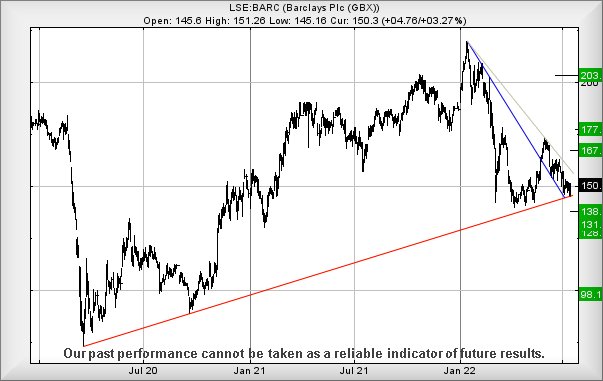UK bank analysis: cool on prospects for Barclays
18th July 2022 07:37
by Alistair Strang from Trends and Targets
Share on
With the UK bank sector results reporting season almost upon us, independent analyst Alistair Strang looks at share price potential for one of the UK's big lenders.

The nightmare of share price inactivity among the UK retail banks continues. But downside at Barclays (LSE:BARC) appears to be checked by the Red line on the chart, the uptrend since the pandemic drop of 2020.
The precision employed with recent relaxation currently ensures we should be confident weakness below 145.51p shall provide an early warning of coming calamity.
Below 145.5p looks very capable of promoting share price reversal down to an initial 138p with secondary, if broken, at 131p or so. This secondary level looks to have the potential of provoking a bounce but, unfortunately, a few of the recent trading caps force us to admit our 131p calculation is a bit woolly insofar as the price could also hit 128p.
- Start of a massive rally phase for Glencore shares?
- Why reading charts can help you become a better investor
What is very strange has been the discipline of price movements since the start of June, the share being extremely carefully marched down the Blue downtrend.
Generally, when this sort of nonsense occurs any recovery tends be quite sharp and fast. The fact “they’ve” proven so methodical about Barclays reversal is a concern as, generally, there’s never any certainty a trend line shall provoke a bounce.
But there is a feeling the market has backed themselves into a corner here, Barclays now needing to trade above just 153.5p to allegedly trigger surprise recovery to an initial 167p with secondary, if bettered, calculating at a theoretical 177p.
We’re a touch cynical about the secondary potential, given it exceeds the recent June high and visually promises great things for the future. Unless the bank share actually manages to close above 177p, we shall be inclined to stay close to the air conditioning and remain fairly cool on its prospects.

Past performance is not a guide to future performance.
Alistair Strang has led high-profile and "top secret" software projects since the late 1970s and won the original John Logie Baird Award for inventors and innovators. After the financial crash, he wanted to know "how it worked" with a view to mimicking existing trading formulas and predicting what was coming next. His results speak for themselves as he continually refines the methodology.
Alistair Strang is a freelance contributor and not a direct employee of Interactive Investor. All correspondence is with Alistair Strang, who for these purposes is deemed a third-party supplier. Buying, selling and investing in shares is not without risk. Market and company movement will affect your performance and you may get back less than you invest. Neither Alistair Strang or Interactive Investor will be responsible for any losses that may be incurred as a result of following a trading idea.
Disclosure
We use a combination of fundamental and technical analysis in forming our view as to the valuation and prospects of an investment. Where relevant we have set out those particular matters we think are important in the above article, but further detail can be found here.
Please note that our article on this investment should not be considered to be a regular publication.
Details of all recommendations issued by ii during the previous 12-month period can be found here.
ii adheres to a strict code of conduct. Contributors may hold shares or have other interests in companies included in these portfolios, which could create a conflict of interests. Contributors intending to write about any financial instruments in which they have an interest are required to disclose such interest to ii and in the article itself. ii will at all times consider whether such interest impairs the objectivity of the recommendation.
In addition, individuals involved in the production of investment articles are subject to a personal account dealing restriction, which prevents them from placing a transaction in the specified instrument(s) for a period before and for five working days after such publication. This is to avoid personal interests conflicting with the interests of the recipients of those investment articles.